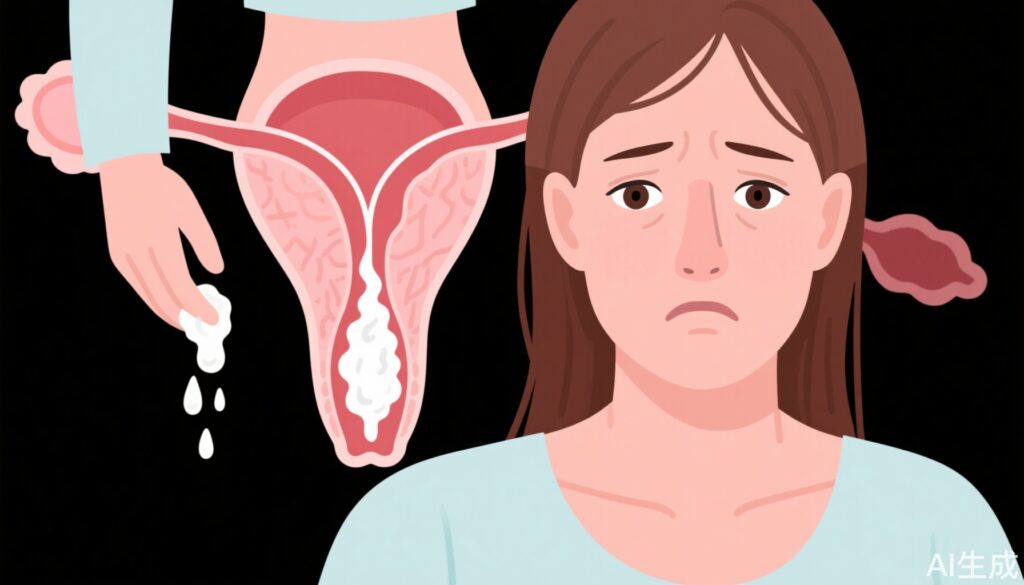Introduction: Understanding White Clumpy Vaginal Discharge
Many women notice white clumpy discharge from the vaginal opening at some point. This symptom, sometimes accompanied by itching, unpleasant odor, redness, or pain, can cause discomfort and concern. Is it a normal physiological phenomenon or a sign of a gynecological condition? Recognizing the characteristics of the discharge is key to understanding its cause and choosing the right treatment.
What Is White Clumpy Vaginal Discharge?
White clumpy discharge refers to secretions that appear in a tofu-like or cottage cheese consistency. It can range from thick and chunky to more fluid and milky. The most common causes include:
1. Yeast Infection (Candidiasis): Caused by the overgrowth of Candida species, this discharge looks like curdled milk or cottage cheese. It is often accompanied by intense itching, burning sensations, and redness of the vulva.
2. Bacterial Vaginosis (BV): Characterized by a thin, grayish-white discharge with a distinct fishy odor. Itching is usually mild or absent.
3. Normal Physiological Discharge: Around ovulation or before and after menstruation, white or slightly increased discharge is normal, milky in appearance, and typically odorless.
How to Identify the Cause?
Consider the following features:
– Appearance: Yeast infections produce thick, clumpy, white discharge resembling tofu curds. BV presents a thin, gray-white discharge. Normal discharge is milky and slightly sticky.
– Odor: Yeast infections usually have no strong odor or a mild yeasty smell. BV has a fishy odor, especially noticeable after intercourse.
– Symptoms: Yeast infections cause significant itching and burning. BV may cause mild discomfort or none at all. Normal discharge is not associated with itching or pain.
When to See a Doctor?
Seek medical attention if:
– Abnormal discharge lasts more than three days.
– Symptoms include itching, redness, swelling, or pain during urination.
– Discharge changes color to yellow, green, or contains blood.
– Symptoms worsen after sexual intercourse.
Why Does White Clumpy Discharge Occur?
1. Yeast Infection (Candidiasis)
– Causes: Weakened immunity, antibiotic misuse, diabetes, wearing tight clothing or prolonged dampness.
– Symptoms: Thick white curd-like discharge, severe vulvar itching, worsens at night.
– Treatment: Antifungal medications such as clotrimazole suppositories or oral fluconazole. Avoid high-sugar diets to reduce fungal growth.
2. Bacterial Vaginosis (BV)
– Causes: Imbalance in vaginal flora with decreased lactobacilli and overgrowth of anaerobic bacteria.
– Symptoms: Thin gray-white discharge with a fishy odor, mild vulvar discomfort.
– Treatment: Metronidazole or clindamycin (oral or vaginal), avoid excessive vaginal washing.
3. Other Potential Causes
– Cervicitis: May cause discharge with blood streaks and post-coital bleeding.
– Trichomoniasis: Frothy yellow-green discharge with intense itching.
– Hormonal Changes: Pregnancy or ovulation can increase discharge without odor or itching.
Scientific Management: How to Handle and Prevent
1. Proper Hygiene Practices
– Clean the vulva with warm water; avoid soaps or internal vaginal washes.
– Wear breathable cotton underwear and change daily; avoid synthetic fabrics.
– Avoid tight pants, change sanitary pads frequently during menstruation, and avoid prolonged sitting in damp conditions.
2. Medical Treatment Recommendations
– Yeast infections: Use clotrimazole suppositories (e.g., Canesten) or oral fluconazole.
– Bacterial vaginosis: Metronidazole gel or oral antibiotics.
– For recurrent infections: Check blood sugar to rule out diabetes and consider vaginal microbiome testing.
3. Preventive Measures
– Avoid overuse of antibiotics to maintain healthy vaginal flora.
– Boost immune function with probiotics (like yogurt), vitamin C, and maintain regular sleep patterns.
– Practice safe sex using condoms to reduce infection risk.
Conclusion
White clumpy vaginal discharge is a common symptom with various causes ranging from normal physiological changes to infections requiring medical treatment. Understanding the nature of the discharge and associated symptoms helps in timely diagnosis and appropriate care. Maintaining good hygiene, adopting healthy lifestyle habits, and seeking medical advice when necessary are key to women’s vaginal health.



